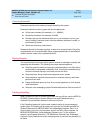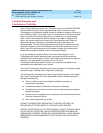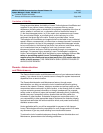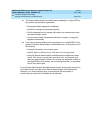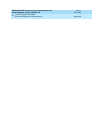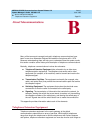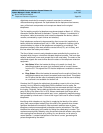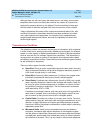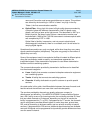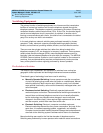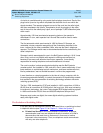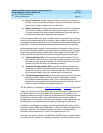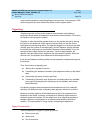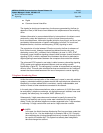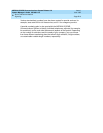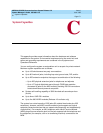
MERLIN LEGEND Communications System Release 5.0
System Manager’s Guide
555-650-118
Issue 1
June 1997
About Telecommunications
Page B-4Transmission Facilities
B
users, and Cannot be used across great distances or oceans. This problem
was solved by the launching in 1962 of a “tower” very high in the sky:
Telstar I
, the first communications satellite.
■ Optical Fiber. A long, hair-thin strand of high-quality glass surrounded by
a sheath of glass with different characteristics, clad in a plastic outer
sheath, and using a laser as the light source. First described in 1887 by a
British physicist, the idea of using light as a transmission medium was
implemented in 1880 by Bell. The first transoceanic undersea optical cable
was completed by AT&T in 1988.
Optical fiber is flexible, inexpensive, and not prone to electrical and
electromagnetic interference; there is no crosstalk, and it is well-suited to
carrying digital signals.
Sometimes these media carry only one signal, while other times they carry many
signals combined together (multiplexed). They also vary greatly in the number of
signals they can carry.
Some of the equipment used in transmission facilities is located at different points
along the transmission media to amplify, and sometimes regenerate, the
transmitted signals. Other transmission equipment is used where transmission
facilities connect to switching systems.
The communications paths provided by transmission facilities can be classified
into three broad categories:
■ Lines. A facility that connects a customer’s telephone extension equipment
and a switching system.
■ Trunks. A facility that connects two switching systems.
■ Channels. A facility dedicated to a specific customer to provide special
services.
As noted earlier in this guide, the differentiation between the terms
line
and
trunk
has blurred and the two terms are now often used interchangeably.
The services provided by channels can greatly enhance a company’s
effectiveness and efficiency. If the MERLIN LEGEND Communications System
has a DS1 facility as one of its incoming trunks, the one facility provides 24 “lines”
that are called
channels
or
B-channels
, depending on the type of service the
facility is programmed for (T1 or PRI). If programmed for T1 service, the channels
can be configured to emulate different types of trunks (loop-start, ground-start,
DID, and tie) according to business needs, and can provide a variety of special
services. If programmed for PRI service, additional special services are available
and each B-channel can be programmed to dynamically provide different services
over the same B-channel.



